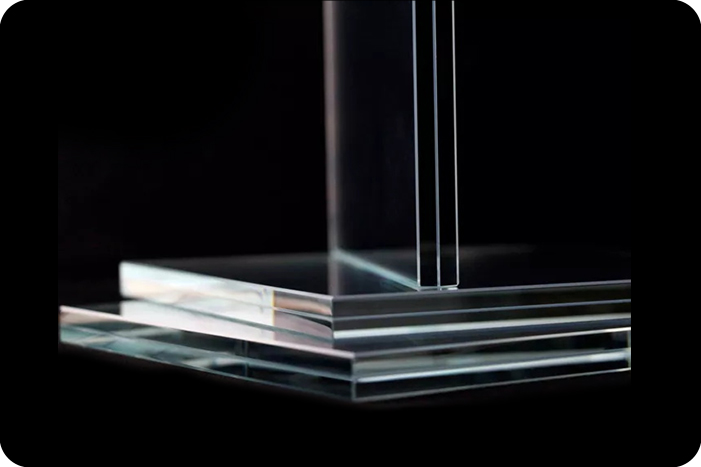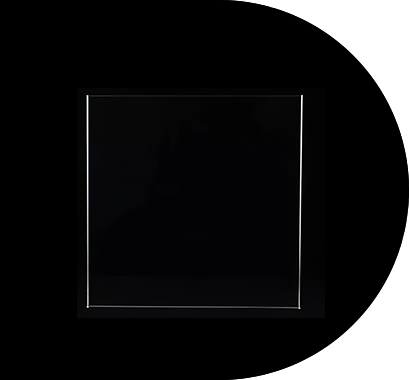Ultra-white laminated glass is increasingly used in public spaces such as museums, galleries, and exhibition halls because it combines exceptional clarity with enhanced safety features. Its laminated construction is key to providing both protection for valuable exhibits and security for visitors. Understanding how laminated construction works helps explain why ultra-white glass is preferred in such high-traffic, high-value environments.
1. Structure of Laminated Glass
Laminated glass consists of two or more layers of glass bonded together with an interlayer, typically made of polyvinyl butyral (PVB), ethylene-vinyl acetate (EVA), or similar polymer films. In the case of ultra-white laminated glass, the glass layers are made from low-iron, ultra-clear glass that eliminates the greenish tint typical of standard glass.
The interlayer serves as a shock-absorbing barrier, holding the glass fragments together if the glass is subjected to impact, breakage, or forced entry. This structure is what differentiates laminated glass from single-pane or standard float glass, which can shatter into sharp, hazardous shards.
2. Enhanced Safety for Visitors
One of the most important benefits of laminated construction is visitor protection. In public spaces such as museums, where large crowds and high foot traffic are common:
- Impact Resistance: Laminated glass can withstand moderate impacts from accidental bumps, falling objects, or even minor vandalism without breaking into dangerous pieces.
- Shatter Prevention: If the glass does break, the interlayer holds fragments in place, preventing injuries from sharp edges. This reduces the risk of cuts or other accidents that could occur with standard glass.
- Controlled Breakage: Laminated construction allows glass to crack without collapsing, providing a visual cue for maintenance while maintaining safety until replacement.
3. Security Against Theft and Vandalism
In addition to safety, laminated construction enhances security, which is particularly important in museums and exhibition areas displaying valuable artifacts:
- Resistance to Forced Entry: Laminated glass is significantly harder to penetrate than single-pane glass. The interlayer acts as a barrier, making it more difficult for intruders to break through quickly.
- Delay Factor: The glass may crack under force, but the interlayer slows down entry, providing valuable time for security personnel to respond.
- Protection of Exhibits: Fragile or irreplaceable items remain shielded even if the glass is damaged, as the interlayer prevents objects from falling or being easily removed.

4. Additional Benefits of Laminated Construction in Public Spaces
- Acoustic Insulation: The interlayer reduces sound transmission, creating quieter environments in museums or galleries.
- UV Protection: Many interlayers filter harmful ultraviolet rays, protecting delicate artworks, textiles, or documents from fading or degradation.
- Durability: Laminated glass resists scratches and wear, maintaining clarity and safety over long-term use in high-traffic areas.
5. Why Ultra-White Glass Matters
Using ultra-white glass in laminated construction enhances both aesthetic and functional performance:
- Optical Clarity: Low-iron, ultra-clear glass provides true color rendering, which is critical in museums where visitors need to see exhibits without color distortion.
- Minimal Tint: The greenish hue typical of standard glass is eliminated, improving transparency and visual experience.
- Seamless Design: Ultra-white laminated panels can be larger and thinner than standard glass while maintaining strength, allowing for elegant display cases and partitions.
Conclusion
The laminated construction of ultra-white glass significantly improves safety and security in public spaces by combining impact resistance, shatter containment, and delayed forced-entry protection. In addition to these safety benefits, laminated glass enhances acoustic performance, blocks UV damage, and maintains crystal-clear visibility for visitors. For museums, galleries, and high-traffic exhibition areas, ultra-white laminated glass offers the perfect balance of aesthetic appeal, visitor safety, and artifact protection, making it an essential material for modern public architecture.





